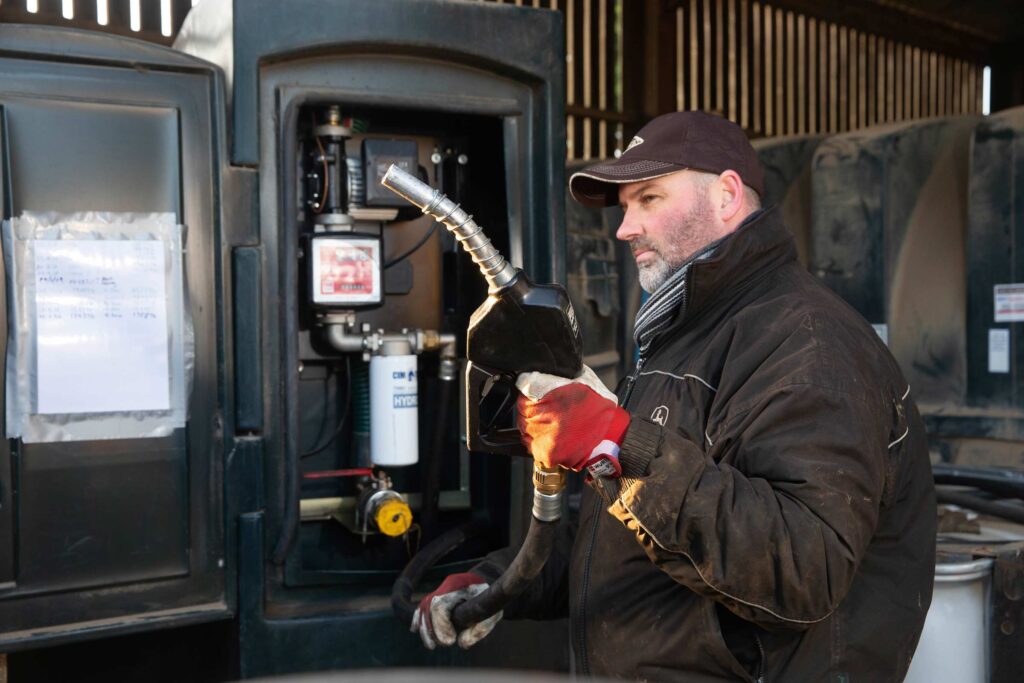UK red diesel prices stable despite conflict in oil regions
 © Tim Scrivener
© Tim Scrivener
Suppliers are encouraging farm businesses to stock up with red diesel now while UK fuel markets remain fairly muted, to avoid future price rises if the conflict in the Middle East escalates further.
Red diesel prices in the UK have remained in the region of 74-80p/litre so far in April, despite heightened tensions in the past week in major oil-producing regions and potential risk to supplies.
See also Ultimate guide to buying a tractor 2024
However, any further escalations between Iran and Israel could lead to future price rallies for fuel.
Brent crude oil stood at US$89.82 (£72) a barrel on 17 April, up almost 16% during the past three months.
Despite this increase oil markets still remain below last autumn’s highs, when prices peaked at $94.43 (£75.70) a barrel in late September.
The numbers
78p
Average red diesel price (/litre) collected by Farmers Weekly on 17 April (based on 5,000 litres delivered)
£72
Price of a barrel of Brent crude oil on 17 April
80%
Percentage of world oil reserves that Opec countries account for
UK market
Red diesel costs in the UK have seen little change during the past six weeks, according to Louisa Beasley of Worcestershire-based fuel supplier Callow Oils.
She said prices went up by 2p/litre overnight last weekend as a knee-jerk reaction to Iran’s drone strikes in Israel, but they had since come back down in line with previous levels.
“With the situation in Gaza, there is always the potential that things could get messy and, as a consequence, the price may escalate. But at the moment, it hasn’t.”
The UK market for fuel remains fairly strong, with colder weather supporting domestic fuel sales.
However, Ms Beasleysaid the market for red diesel had been fairly subdued, with farmers hampered by wet ground conditions.
This view was echoed by Neil Cooper, marketplace manager at Yagro, who said UK demand had been intermittently stunted due to the unprecedented wet weather limiting the ability for agricultural activity.
He said prices had largely remained at about 74p/litre, and 76p/litre for orders of between 8,000 litres and 10,000 litres, with prices having peaked in February at 79p/litre.
As well as conflict in the Middle East, Mr Cooper said fears about US interest rate rises continued to influence markets, and ongoing increased demand from China had added some price pressure.
Rix Petroleum managing director Duncan Lambert said that just like farmers, distributors are controlled by the weather.
“If you look at the refinery situation, there is a lot of product around the whole of the country that is just sat there waiting for the green light to go.
“With demand low because of the weather, there is an abundance of product stabilising the shock events of anywhere else in the world on price.”
Mr Lambert said if the weather picked up and everybody got out planting, prices would probably rise.
He advised farm businesses to top up fuel tanks now while quotes are close to the bottom of the market.
One farmer buying group told Farmers Weekly the number of fuel orders from its members had started to pick up in the past few days.
Global supply and demand
Opec member countries account for almost 80% of world crude oil reserves, with most of these situated in the Middle East.
Opec’s April oil market report said ongoing geopolitical tensions had added to the supply risk premium. It also forecast that global oil demand could grow by 2.2m barrels/day in 2024, due strong to demand in Asia.
CMA concerns over fuel margins
The Competition and Markets Authority (CMA) is continuing to investigate uncompetitive fuel markets in the UK, with fuel margins still high.
Dan Turnbull, CMA senior director of markets, said: “Drivers are feeling the pinch as fuel prices have been edging up since January. We’re particularly concerned by high margins, which indicate weakened competition and are not a good sign for drivers.”
A report found fuel margins at supermarkets had increased from 4% in 2017 to 7.8% in 2023, while margins at other retailers had risen from 6.4% in 2017 to 9.1% in 2023.
